MAC's Believe It Or Not!
by John McDougald
Reprinted from "Crown Jewels of the Wire", July 1994, page 23
I thought that it was time to share some new finds with you that I have
received correspondence on over the past year. The first is probably the most
spectacular, but depending on your particular interest, all are of interest and
add to our overall knowledge of the fascinating hobby we enjoy.
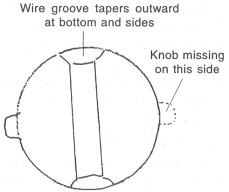
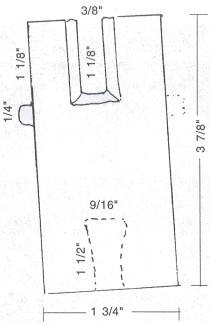
Sketch of slash top threadless insulator
The following
information comes from Russell Sprague, Pasadena, Maryland. I'll quote liberally
from his letter. "Enclosed is a photo and a sketch showing the dimensions
of an interesting insulator I recently acquired. It was found along the route of
the first telegraph line that ran between Baltimore and Washington DC. In
talking with other collectors in the hobby (Russell brought this piece to the
London, Ohio show last fall and showed it to several of our historical experts),
their guess is that it dates to the time right after the 'bureau knob', probably
used only in that area and in a small number as a trial."
"The dimensions are indicated on the sketch (see above). The wire groove
is slanted downward at the bottom edges, likewise the sidewalls of the groove
are tapered outward at the edges. There is a small button 90 degrees to the wire
groove and evidence of another on the opposite side that appears to have been
broken off. The pinhole is interesting in that it is not deep and flares out at
the top, similar to the 'bureau knob'. The glass is off clear, sort of like the
early Sandwich glass of that period. If all of our assumptions are correct, this
could be a very important part of early telegraph history."
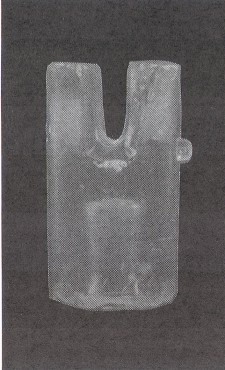
I had a chance to photograph this piece at London, Ohio and inspect it up
close. I continue to be amazed at the variety of new finds that are turning up.
This is a great addition to our body of knowledge, although much research
remains to be done to determine manufacturer, specific use, etc. Thanks,
Russell.
In the editor's never ending quest to add to her foreign insulator
collection, she spoke with Frank Ikeman, a lightning rod ball collector from our
area. Frank indicated that he had been on a fishing trip to Eastern Russia, had traveled
to one of the concentration camps in that area and had acquired a few
insulators. Was she interested? What a question!!! But what a surprise when
Frank showed up with a CD 103 No Name in teal blue with a standard I"
pinhole. Needless to say, a trade was worked out. Below is a picture of the
Russian guide removing the insulator from its original resting place. (The
service in this area had been shut down since shortly after WWII, so there was
no danger of electrical shock.)
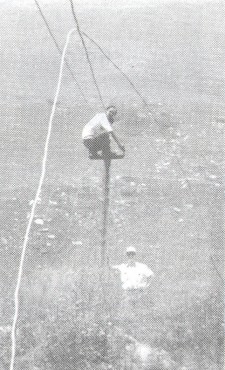
We thought that we had better let N .R
"Woody" Woodward take a look at this new acquisition. Here are some
excerpts from his analysis. "This insulator was made in a hand press with
badly fitting mold parts. There was a heavy fin around the base that was ground
off, as well as the prominent one around the sides and top. However the press was of the later style
that involved the mandrel being plunged into the hot glass instantly. Except for
poor quality of threads, the interior looks to be World War I era. This makes me
think it is quite possible the insulator is in fact US made and found its way
over there during the war. However, with the two-piece mold, it would not have
been made by a major manufacturer of that period. The thread is slightly
undersized and reminds me of that bad mandrel that was used in Lynchburg No.
181."
As usual, Woody adds some wonderful insights to the new finds. At
any rate, this is the first report of a CD 103 No Name, and we are inclined to agree that it is U.S. manufacture.
It will be listed in the price guide update.
The next variation comes from Janet Bond, Antioch, California. As you can see from the picture below, Janet has come
up with a very interesting CD 158.2. In comparing it with the one pictured in
our reference book, it has a more pronounced lower wire groove ridge, a smaller
upper wire groove ridge, and a smaller and slightly more tapered dome. There are
vestiges of dome embossing on this piece, it has four segmented threads and is
blue aqua in color. I had not seen one with this particular profile, but my
Boston Bottle experts tell me that there is quite a bit of variation in the
appearance of the CD 158.2's, much like the CD 158 variations. This one is
certainly less common that the more standard style. Thanks for sharing your acquisition
with us, Janet.
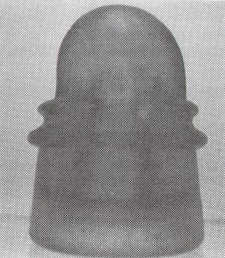
Unusual CD 158.2
George McGowan, Miami, Florida, proves that you don't have to
walk the lines for a new find. The insulator pictured below was purchased at the
Denver National last year. It is a CD 185 Jeffrey Mine Insulator, but the word
'insulator' is spelled INSULATOL. I know as I write this that this embossing
will be difficult to read in the magazine, but trust me. There has been some
rework on the engraving, but what is left after the rework is clearly an
embossing error. Thanks for the new listing, George.
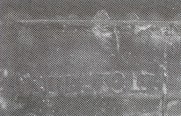
INSULATOL
Finally, a speculation, and
a good one in my opinion, from Gene Condon, North Charleston, South Carolina.
Gene is the most prolific collector of the rare Salamander lightning rod
insulator. Most of us have never seen one (picture missing), let alone owned one,
and Gene, as of last report, had them in four different colors. At any rate,
Gene writes, "I have been mystified by the name 'Salamander' on Robert D.
Dwyer's July 3, 1855 patent lightning rod insulator. The insulator doesn't look like the lizard-like salamander, and no
person, place or manufacturer is known with that name.
"The other day I was
looking through 19th century ads and came across one for 'Tilton &
McFarland's Salamander Safe.' Huh!! A quick look in the dictionary told of the
mythological salamander, describing it as 'able to endure or live in fire'.
Nineteenth century folk were keen on mythology. They also called lightning 'fire
from heaven '. Click! I think I have the answer now. "
I think you're absolutely right, Gene. Thanks.
Thanks to all who contributed to the new finds in this month's article. If
you have some information you'd like to share, drop me a line, and I'll pass it
along to the rest of the hobby, "Believe it or Not!"
(Missing picture for this caption: Two Salamander Patent Lightning Rod Insulators. The one on the left is a
clear clam-broth color, while the one on the right if olive green.)
| 